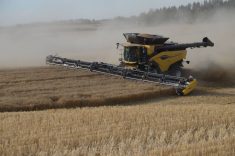WINNIPEG — Most farmers can handle a tight year like this one, says Farm Credit Canada’s chief economist.
“On the balance sheet front, things look awesome,” said J.P. Gervais in an interview, referring to Statistics Canada 2022 farm debt and equity numbers.
“Asset values have been trending up. Equity has gone up, so that’s good news.”
StatCan numbers put Canadian farmers at a relatively low debt-to-equity ratio, at about 17.7 percent, which is below the 10-year average.
That means farmers are carrying relatively low levels of debt compared to their assets and are not highly exposed to a debt-servicing squeeze.
Read Also

Livestock leads Canada’s farm economic outlook
Forecasts by a major Canadian farm lender featured good and bad news on the financial health of both farmers and Canadians at large.
However, Gervais notes the data does not reveal the particular circumstances of individual farms. Farmers with poor production due to drought might be carrying more debt. Farmers who have expanded and took on more debt at higher rates will face higher interest charges than those with long-term debt set at low rates.
“Aggregate data can hide a lot of stories,” said Gervais.
Some will face an unpleasant reality if they need to renew debt this year. Interest rates are higher so debt will be more painful to carry.
That’s why Gervais said the debt-to-equity ratio and other balance sheet measures aren’t the best gauge for farmers’ exposure to debt servicing costs. Income statement ratios play a bigger role.
Farmers in 2023-24 will face “tighter” financial situations because crop prices have fallen, many input prices were locked in at high prices, and interest rates are much higher.
Farm debt is not evenly spread. Older farmers with mature operations or those nearing retirement often have no long-term debt and deal only with working capital borrowing.
Younger farmers and those trying to expand generally carry more debt to finance asset purchases such as land.
The balance sheet can look great, with rising land prices more than compensating for increased debt levels, but paying for that debt is a squeeze when crop prices fall.
If the need for debt renewal does occur this year, farmers appear well-positioned to handle it.
“If you look at the balance sheet at the aggregate level, it looks awesome,” said Gervais.
















